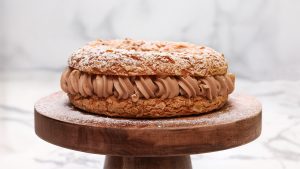Recipe by Kirsten Tibballs
This technical class covers the ins and outs of creating shortbread dough as well as rolling, lining and sealing a tart shell. Kirsten shares The Ultimate Shortbread recipe, as well as several variations including the addition of nuts, baking powder, reducing sugar and flour, just to name a few!
The Ultimate Shortbread
120g (4.23oz)
unsalted butter
65g (2.29oz)
pure icing (confectioner's) sugar
50g (1.76oz)
whole egg
2g (0.07oz)
salt
290g (10.23oz)
plain (all-purpose flour)
plain flour, for dusting
80mm D x 20mm H
tart rings
120mm
round cutter
Base Dough With Addition of Nuts
120g (4.23oz)
unsalted butter
65g (2.29oz)
pure icing (confectioner's) sugar
50g (1.76oz)
whole egg
2g (0.07oz)
salt
230g (8.11oz)
plain (all-purpose flour)
60g (2.12oz)
almond meal (ground almond)
Base Dough With Addition Of Baking Powder
120g (4.23oz)
unsalted butter
65g (2.29oz)
pure icing (confectioner's) sugar
50g (1.76oz)
whole egg
2g (0.07oz)
salt
290g (10.23oz)
plain (all-purpose flour)
5g (0.18oz)
baking powder
Base Dough With Reduced Sugar
120g (4.23oz)
unsalted butter
30g (1.06oz)
pure icing (confectioner's) sugar
50g (1.76oz)
whole egg
2g (0.07oz)
salt
290g (10.23oz)
plain (all-purpose flour)
uncooked rice or baking beads, for blind baking
Base Dough With Caster Sugar
120g (4.23oz)
unsalted butter
65g (2.29oz)
caster (superfine) sugar
50g (1.76oz)
whole egg
2g (0.07oz)
salt
290g (10.23oz)
plain (all-purpose flour)
Base Recipe With Increased Butter
290g (10.23oz)
unsalted butter
65g (2.29oz)
pure icing (confectioner's) sugar
50g (1.76oz)
whole egg
2g (0.07oz)
salt
290g (10.23oz)
plain (all-purpose flour)
Base Dough With Reduced Flour
120g (4.23oz)
unsalted butter
65g (2.29oz)
caster (superfine) sugar
50g (1.76oz)
whole egg
2g (0.07oz)
salt
200g (7.05oz)
plain (all-purpose flour)
The Ultimate Shortbread (Base Recipe)
- In the bowl of a stand mixer fitted with a paddle attachment, mix the butter and icing sugar until there are no lumps of butter remaining.
- Add in the egg and mix to combine.
- Lastly add in the salt and flour, continue to mix until the ingredients just come together as a dough.
- Press the dough into an even flat square
- and wrap in plastic wrap before placing into the refrigerator for a minimum of 30 minutes.
- Heat the oven to 155°C (311°F), fan forced.
- On a lightly floured workbench, roll the dough out to 2-3mm in thickness.
- Use a round cutter, 120mm in diameter, to cut the dough into discs.
- Line the tart rings with the dough and place them onto a baking tray lined with a Silpain Mat.
- Chill the tart cases for 30 minutes before trimming the excess dough off the top with a sharp knife.
- If the tarts are going to have a baked filling, partially bake the cases in the pre-heated oven for 15 minutes before adding in the liquid filling and continuing to bake.
- To fully bake the tart case, bake in the pre-heated oven for 30 minutes.
ROLLING, LINING AND BAKING NOTES
EQUIPMENT
- Solid tart rings do not allow air to travel through which can cause air-bubbles on the surface of the baked pastry.
- Perforated tart rings allow air to flow through which results in a smoother, more even tart case, without lumps, cavities or bumps on the surface.
- Silpain Baking Mats have a perforated texture which allows air to flow through. Using a Silpain Mat allows any trapped air between the mat and the tray to release. The Silpain Mat can be used in conjunction with either a solid aluminium baking tray or a perforated baking tray.
- If you do not have a Silpain Mat, you can use a standard baking tray in conjunction with baking paper or a regular baking mat. This may result in some air-bubbles on the surface of the baked pastry.
- Egg rings can be used as a substitute for individual tart rings.
ROLLING
- For easier handling while rolling, cut the dough in half and work with half at a time.
- Lightly dust the surface of your workbench with plain (all-purpose) flour. Roll the pastry as evenly as possible, without too much pressure.
- To ensure the dough does not stick to the bench, after rolling the dough a few times, lift it up and add more flour to the workbench if required.
- If your room temperature is warm and the dough begins to soften, place it back into the fridge for 10-20 minutes to firm up.
- If you are in a warm environment, you can roll the dough between 2 sheets of baking paper or 2 guitar sheets. Roll the dough to a thickness of 2-3mm.
- Use a cutter which is larger than the diameter of the tart ring to cut discs of the dough.
- Do not overwork the off-cuts of dough. If you are working with half the dough at a time, remove the excess flour from the off-cuts, fold and press them into itself before adding them to the second half of dough.
LINING
- You can line a tart ring with a single piece of pastry or two – a base and strip of dough for the sides.
- Gently press the pastry into the tart ring. If using one piece of dough, ensure you push the pastry right into the corners of the base.
- If the dough has not been pressed into the corners of the base, the pastry will sink down into the corners while baking and result in an uneven top.
- Chill the lined tart shells for 30 minutes before trimming the excess dough off the tops with a sharp knife. Ensure the knife is not angled while trimming.
BAKING
- If you follow the same steps that Kirsten takes to roll the pastry, The Ultimate Shortbread recipe provided does not require blind-baking with a lining.
- Blind-baking with a lining is when you line the tart shell with heat-proof plastic wrap or baking paper, fill it with uncooked rice or baking beads and partially bake the tart shell before removing the rice and continuing to bake.
- Blind-baking ensures the pastry holds its shape while baking.
- To fully bake the tart case, bake in the pre-heated oven for 30 minutes.
- For a tart with a baked filling, partially bake in the pre-heated oven for 15 minutes before adding in the liquid filling and continuing to bake.
- A partially baked tart case should not have any wet pastry on the base.
- To avoid the tart shell losing its shape, keep the partially baked tart case in the ring when you add the liquid filling and continue to bake.
- Do not let the liquid filling go over the edge or between the tart case and the ring, otherwise it will stick.
- Overworked, or overmixed, dough is very difficult to handle. It will crack and separate when rolled.
- There is no way to fix the dough once it is overworked. You can, however, make a fresh batch of dough, ensuring you do not overmix it, and add small amounts of the overworked dough into it.
- The texture of overworked dough, after it has been baked, is tough. It is difficult to cut, not buttery in texture and does not have a crumbly mouth-feel.
BASE DOUGH WITH ADDITION OF NUTS
- In the bowl of a stand mixer fitted with a paddle attachment, mix the butter and icing sugar until there are no lumps of butter remaining.
- Add in the egg and mix to combine.
- Lastly add in the salt, flour and almond meal, continue to mix until the ingredients just come together as a dough.
- Press the dough into an even flat square and wrap in plastic wrap before placing into the refrigerator for a minimum of 30 minutes.
- Heat the oven to 155°C (311°F), fan forced.
- On a lightly floured workbench, roll the dough out to 2-3mm in thickness.
- Use a round cutter, 120mm in diameter, to cut the dough into discs.
- Line the tart rings with the dough and place them onto a baking tray lined with a Silpain Mat.
- Chill the tart cases for 30 minutes before trimming the excess dough off the top with a sharp knife.
- If the tarts are going to have a baked filling, partially bake the cases in the pre-heated oven for 15 minutes before adding in the liquid filling and continuing to bake.
- To fully bake the tart case, bake in the pre-heated oven for 30 minutes.
NOTES
- If you follow the same steps that Kirsten takes to roll the pastry, this variation can be blind-baked without a lining.
- Adds more fat to the recipe which results in a crumblier and slightly softer texture.
- Imparts a nut flavour into the pastry.
- The pastry will have a slightly darker colour.
BASE DOUGH WITH ADDITION OF BAKING POWDER
- In the bowl of a stand mixer fitted with a paddle attachment, mix the butter and icing sugar until there are no lumps of butter remaining.
- Add in the egg and mix to combine. Lastly add in the salt, flour and baking powder, continue to mix until the ingredients just come together as a dough.
- Press the dough into an even flat square and wrap in plastic wrap before placing into the refrigerator for a minimum of 30 minutes.
- Heat the oven to 155°C (311°F), fan forced.
- On a lightly floured workbench, roll the dough out to 2-3mm in thickness.
- Use a round cutter, 120mm in diameter, to cut the dough into discs. Line the tart rings with the dough and place them onto a baking tray lined with a Silpain Mat.
- Chill the tart cases for 30 minutes before trimming the excess dough off the top with a sharp knife.
- If the tarts are going to have a baked filling, partially bake the cases in the pre-heated oven for 15 minutes before
- adding in the liquid filling and continuing to bake.
- To fully bake the tart case, bake in the pre-heated oven for 30 minutes.
NOTES
- If you follow the same steps that Kirsten takes to roll the pastry, this variation can be blind-baked without a lining.
- The baking powder chemically aerates the pastry, enabling the pastry to rise during the baking process. It creates a slightly thicker pastry which is easy to cut.
- The texture of the baked pastry is very short and crumbly.
- The finished tart shell can be a little fragile.
- The baking powder does not impart any flavour.
- The pastry will have a light golden-brown colour once baked.
BASE DOUGH WITH REDUCED SUGAR
- In the bowl of a stand mixer fitted with a paddle attachment, mix the butter and icing sugar until there are no lumps of butter remaining.
- Add in the egg and mix to combine.
- Lastly add in the salt and flour, continue to mix until the ingredients just come together as a dough. Press the dough into an even flat square
- and wrap in plastic wrap before placing into the refrigerator for a minimum of 30 minutes.
- Heat the oven to 155°C (311°F), fan forced.
- On a lightly floured workbench, roll the dough out to 2-3mm in thickness.
- Use a round cutter, 120mm in diameter, to cut the dough into discs.
- Line the tart rings with the dough and place them onto a baking tray lined with a Silpain Mat.
- Chill the tart cases for 30 minutes before trimming the excess dough off the top with a sharp knife.
- Line the tart shells with heat-proof plastic wrap, or baking and fill with uncooked rice.
- If the tarts are going to have a baked filling, partially bake the cases in the pre-heated oven for 15 minutes before removing the lining, adding in the liquid filling and continuing to bake.
- To fully bake the tart case, bake in the pre-heated oven for 30 minutes, removing the lining after 15 minutes.
NOTES
- This pastry is suitable for both sweet and savoury applications.
- Cannot be blind-baked without a lining.
- The dough is slightly more fragile and brittle to roll and work with.
- The pastry is flaky in texture and prone to small, hairline cracks.
BASE DOUGH REPLACING ICING SUGAR FOR CASTER SUGAR
- In the bowl of a stand mixer fitted with a paddle attachment, mix the butter and caster sugar until there are no lumps of butter remaining.
- Add in the egg and mix to combine.
- Lastly add in the salt and flour, continue to mix until the ingredients just come together as a dough.
- Press the dough into an even flat square
- and wrap in plastic wrap before placing into the refrigerator for a minimum of 30 minutes.
- Heat the oven to 155°C (311°F), fan forced.
- On a lightly floured workbench, roll the dough out to 2-3mm in thickness.
- Use a round cutter, 120mm in diameter, to cut the dough into discs.
- Line the tart rings with the dough and place them onto a baking tray lined with a Silpain Mat.
- Chill the tart cases for 30 minutes before trimming the excess dough off the top with a sharp knife.
- If the tarts are going to have a baked filling, partially bake the cases in the pre-heated oven for 15 minutes before adding in the liquid filling and continuing to bake.
- To fully bake the tart case, bake in the pre-heated oven for 30 minutes.
NOTES
- If you follow the same steps that Kirsten takes to roll the pastry, this variation can be blind-baked without a lining.
- The dough is slightly firmer and drier to work with.
- The caster sugar tends not to dissolve as easily resulting in crisp and crunchier texture as well as a mottled appearance to the pastry.
BASE RECIPE WITH INCREASED BUTTER
- In the bowl of a stand mixer fitted with a paddle attachment, mix the butter and icing sugar until there are no lumps of butter remaining.
- Add in the egg and mix to combine.
- Lastly add in the salt and flour, continue to mix until the ingredients just come together as a dough.
- Press the dough into an even flat square and wrap in plastic wrap before placing into the refrigerator for a minimum of 30 minutes.
- Heat the oven to 155°C (311°F), fan forced.
- On a lightly floured workbench, roll the dough out to 2-3mm in thickness.
- Use a round cutter, 120mm in diameter, to cut the dough into discs.
- Line the tart rings with the dough and place them onto a baking tray lined with a Silpain Mat.
- Chill the tart cases for 30 minutes before trimming the excess dough off the top with a sharp knife.
- If the tarts are going to have a baked filling, partially bake the cases in the pre-heated oven for 15 minutes before adding in the liquid filling and continuing to bake.
- To fully bake the tart case, bake in the pre-heated oven for 30 minutes.
NOTES
- If you follow the same steps that Kirsten takes to roll the pastry, this variation can be blind-baked without a lining.
- The dough is slightly softer and difficult to work with. It is important to work quickly to ensure the dough doesn’t become too warm.
- The pastry will shrink during baking, resulting in a smaller and shorter tart shell.
- The baked pastry has a beautiful rich buttery flavour and flaky texture. The finished tart shell can be a little fragile.
BASE DOUGH WITH REDUCED FLOUR
- In the bowl of a stand mixer fitted with a paddle attachment, mix the butter and icing sugar until there are no lumps of butter remaining.
- Add in the egg and mix to combine.
- Lastly add in the salt and flour, continue to mix until the ingredients just come together as a dough.
- Press the dough into an even flat square and wrap in plastic wrap before placing into the refrigerator for a minimum of 30 minutes.
- Heat the oven to 155°C (311°F), fan forced.
- On a lightly floured workbench, roll the dough out to 2-3mm in thickness.
- Use a round cutter, 120mm in diameter, to cut the dough into discs.
- Line the tart rings with the dough and place them onto a baking tray lined with a Silpain Mat.
- Chill the tart cases for 30 minutes before trimming the excess dough off the top with a sharp knife.
- If the tarts are going to have a baked filling, partially bake the cases in the pre-heated oven for 15 minutes before adding in the liquid filling and continuing to bake.
- To fully bake the tart case, bake in the pre-heated oven for 30 minutes.
NOTES
- If you follow the same steps that Kirsten takes to roll the pastry, this variation can be blind-baked without a lining.
- The dough is slightly more challenging to roll out and softer to handle.
- Results in a sweeter flavour and crunchier texture.
- The pastry has is a dark golden-brown colour once baked.












